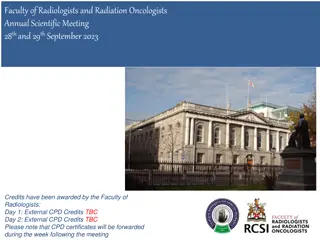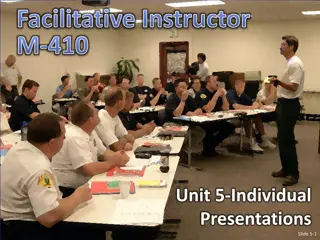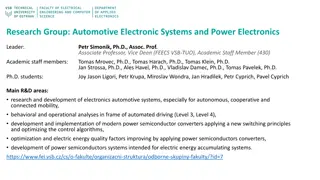
Unpacking the Role of Local Authorities in (De)centralizing Tendencies
Explore the evolving landscape of governance with a focus on decentralization, the involvement of local authorities, and the crucial role of civic sector organizations in bridging the gap between government and citizens. Delve into multi-level governance, dimensions of governance, and the importance of coordinated networks in fostering effective decision-making processes.
Download Presentation

Please find below an Image/Link to download the presentation.
The content on the website is provided AS IS for your information and personal use only. It may not be sold, licensed, or shared on other websites without obtaining consent from the author. If you encounter any issues during the download, it is possible that the publisher has removed the file from their server.
You are allowed to download the files provided on this website for personal or commercial use, subject to the condition that they are used lawfully. All files are the property of their respective owners.
The content on the website is provided AS IS for your information and personal use only. It may not be sold, licensed, or shared on other websites without obtaining consent from the author.
E N D
Presentation Transcript
(De)centralizing tendencies and the role of local authorities and civic sector organizations in bringing the government closer to citizens Petr Witz 25 May 2016
Ultimate interest of the local government
Ultimate public interest ? ? ? Re-election Profit max Welfare max Government Citizens Business Source: PW
Multi-level governance the age of sovereign nation-states is over. While most governance still takes place at the national level, the share of governance at a higher, supra-national level, and a lower, especially regional, level is increasing (Z rn, Leibfried 2005, p. 25; Pierre, Peters 2000). Supra-national governance: global level (UN, OECD, IMF, WB, G8, ); level of regional integration projects (EU).
Dimensions of governance Governance cannot be reduced to the level of nation- states; one must take into regard its supra-national level, but also its regional level. Dimensions: Multi-level governance (MLG). Regulators: market, government, civic sector + media Horizontal links and informal networks success contingent upon performance of a network as a whole not just on efficiency of individual units Good governance is based on synchronization of decision making and policy implementation both within the vertical hierarchy and within the horizontal network of actors
Coordinated network City council Department A CommitteeB Business A NGO B
Role of local governance each public service should be provided by the jurisdiction having control over the minimum geographic area that would internalize benefits and costs of such provision (Oates, 1972) because: A) local governments understand concerns of local residents; B) local decision making is responsive to the people for whom the services are intended, thus encouraging fiscal responsibility and efficiency, especially if financing of services is also decentralized; C) unnecessary layers of jurisdictions are eliminated; D) inter-jurisdictional competition and innovation are enhanced
Systems of local administration systems differ in the number of tiers of local administration, size of administrative units, coverage, level of independence and scope of competencies advanced countries tend to have less tiers of local government and smaller sized units covering less people providing more services and featuring more competencies
Decentralization Process of redistributing powers, functions and competencies from central authority towards local authorities Various intensity across countries In some countries centralism still strong and getting stronger X decentralizing tendencies prevalent in most developed countries Level of decentralization can be measured using various proxies
Relative importance and security of existence Significance of local government best expressed by share of spending relative to central government (easily accessible from most national statistics) Security depends on safeguards against dismissal by external influences Scale: A) legislative safeguards against dismissal by CG B) LG can be dismissed under certain conditions C) LG can be dismissed in arbitrary situations 1 0,5 0
Share of local government spending 70 60 50 40 30 20 10 0
Dimensions of decentralization A) fiscal independence of local budgets from central financing B) political level of autonomy elections/appointments and application of direct democracy principles C) administrative - share of employment, capacities and competencies
Fiscal decentralization Vertical fiscal gap difference between the resources available to local authority and resources needed gap that needs to be filled with money from central government Taxation autonomy powers to collect taxes and set their rates Unconditional transfers to what extent the local authorities need to qualify to obtain funding Spending autonomy to what extent is the local authority free to spend its money at will Borrowing autonomy to what extent there are limits for local government raising money through debt only a small minority of countries don t place any restrictions on LG borrowing
Measurement and scale Measuring either based on quantitatitve data statistics available or collected by your own organization In case of qualitative information need to operationalize data and translate them into codes/numbers through defining a scale and assigning values to individual variables Example: a) borrowing not regulated b) regulated threshold/conditions 0,5 c) borrowing not allowed 1 0
Political decentralization Elections: To what extent do the local assemblies, councils and mayors/governors get directly elected/appointed? Direct democracy: To what extent attributes and tools of direct democracy are utilized: use of referenda, public hearings or citizen assemblies, impact of petitions, possibility to initiate referenda?
Administrative decentralization HR policies: What is the share of local government employees on general government (total number of government) employees? Employment shares: To what extent there s an opportunity for the local authorities to emloy and fire employees and set the rules of employment at their own discretion
Role of NGOs in bringing the government closer to citizens governments are responsible for providing access to decision making and providing RAW data X they are often not in position or unable to interpret the data the NGOs should be ready to pressure the government to provide even more info and to visualize the data in a user-friendly way
Good governance at local level 12 principles of GG at LL according to the Council of Europe: Good conduct of elections Representation and participation Responsiveness Efficiency and effectiveness Openness and transparency Rule of law Ethical conduct Competence and capacity Innovation and openness to change Sustainability and long-term orientation Sound financial management Human rights Cultural diversity and social cohesion Accountability Source: Council of Europe
Fair Conduct of Elections, Representation and Participation Local elections are conducted freely and fairly, according to international standards and national legislation, and without any fraud. Citizens are at the centre of public activity and they are involved in clearly defined ways in public life at local level. All men and women can have a voice in decision-making, either directly or through legitimate intermediate bodies that represent their interests. Such broad participation is built on the freedoms of expression, assembly and association. All voices, including those of the less privileged and most vulnerable, are heard and taken into account in decision-making, including over the allocation of resources. There is always an honest attempt to mediate between various legitimate interests and to reach a broad consensus on what is in the best interest of the whole community and on how this can be achieved. Decisions are taken according to the will of the many, while the rights and legitimate interests of the few are respected.
Responsiveness Objectives, rules, structures, and procedures are adapted to the legitimate expectations and needs of citizens. Public services are delivered, and requests and complaints are responded to within a reasonable timeframe.
Efficiency and effectiveness Results meet the agreed objectives. Best possible use is made of the resources available. Performance management systems make it possible to evaluate and enhance the efficiency and effectiveness of services. Audits are carried out at regular intervals to assess and improve performance
Openness and Transparency Decisions are taken and enforced in accordance with rules and regulations. There is public access to all information which is not classified for well-specified reasons as provided for by law (such as the protection of privacy or ensuring the fairness of procurement procedures). Information on decisions, implementation of policies and results is made available to the public in such a way as to enable it to effectively follow and contribute to the work of the local authority.
Rule of law The local authorities abide by the law and judicial decisions. Rules and regulations are adopted in accordance with procedures provided for by law and are enforced impartially.
Ethical conduct the public good is placed before individual interests. There are effective measures to prevent and combat all forms of corruption. Conflicts of interest are declared in a timely manner and persons involved must abstain from taking part in relevant decisions.
Competencies and capacity The professional skills of those who deliver governance are continuously maintained and strengthened in order to improve their output and impact. Public officials are motivated to continuously improve their performance. Practical methods and procedures are created and used in order to transform skills into capacity and to produce better results.
Sources Ivanyna, M. and Shah, A. (2013) How Close Is Your Government to Its People? Worldwide: Indicators on Localization and Decentralization. https://ideas.repec.org/a/zbw/ifweej/20143. html






















